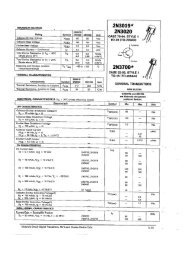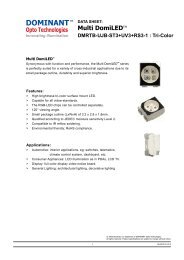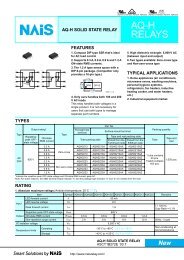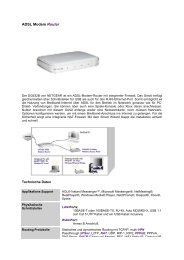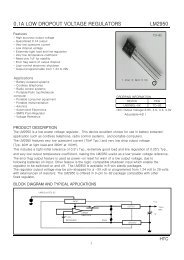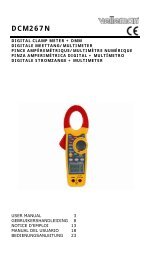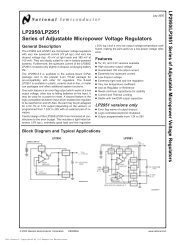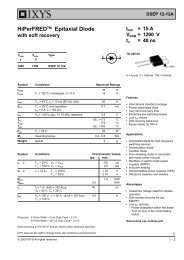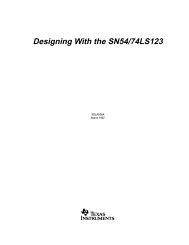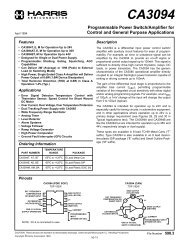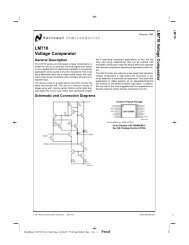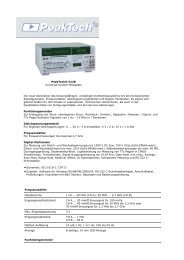ICM7216B, ICM7216D - EBG - Darmstadt
ICM7216B, ICM7216D - EBG - Darmstadt
ICM7216B, ICM7216D - EBG - Darmstadt
Create successful ePaper yourself
Turn your PDF publications into a flip-book with our unique Google optimized e-Paper software.
8-Digit, Multi-Function, Frequency<br />
Counters/Timers<br />
®<br />
The <strong>ICM7216B</strong> is a fully integrated Timer Counters with LED<br />
display drivers. They combine a high frequency oscillator, a<br />
decade timebase counter, an 8-decade data counter and<br />
latches, a 7-segment decoder, digit multiplexers and 8segment<br />
and 8-digit drivers which directly drive large<br />
multiplexed LED displays. The counter inputs have a<br />
maximum frequency of 10MHz in frequency and unit counter<br />
modes and 2MHz in the other modes. Both inputs are digital<br />
inputs. In many applications, amplification and level shifting<br />
will be required to obtain proper digital signals for these<br />
inputs.<br />
The <strong>ICM7216B</strong> can function as a frequency counter, period<br />
counter, frequency ratio (f A /f B ) counter, time interval<br />
counter or as a totalizing counter. The counter uses either a<br />
10MHz or 1MHz quartz crystal timebase. For period and<br />
time interval, the 10MHz timebase gives a 0.1µs resolution.<br />
In period average and time interval average, the resolution<br />
can be in the nanosecond range. In the frequency mode, the<br />
user can select accumulation times of 0.01s, 0.1s, 1s and<br />
10s. With a 10s accumulation time, the frequency can be<br />
displayed to a resolution of 0.1Hz in the least significant<br />
digit. There is 0.2s between measurements in all ranges.<br />
The <strong>ICM7216D</strong> functions as a frequency counter only, as<br />
described above.<br />
All versions of the ICM7216 incorporate leading zero<br />
blanking. Frequency is displayed in kHz. In the <strong>ICM7216B</strong>,<br />
time is displayed in µs. The display is multiplexed at 500Hz<br />
with a 12.2% duty cycle for each digit. The <strong>ICM7216B</strong> and<br />
<strong>ICM7216D</strong> are designed for common cathode displays with<br />
typical peak segment currents of 12mA. In the display off<br />
mode, both digit and segment drivers are turned off,<br />
enabling the display to be used for other functions.<br />
Part Number Information<br />
PART<br />
NUMBER<br />
OBSOLETE PRODUCT<br />
NO RECOMMENDED REPLACEMENT<br />
contact our Technical Support Center at<br />
1-888-INTERSIL or www.intersil.com/tsc<br />
TEMP. RANGE<br />
( o C) PACKAGE PKG. NO.<br />
<strong>ICM7216B</strong>lPl -25 to 85 28 Ld PDIP E28.6<br />
<strong>ICM7216D</strong>lPl -25 to 85 28 Ld PDIP E28.6<br />
1<br />
Data Sheet January 2004<br />
Features, All Versions<br />
<strong>ICM7216B</strong>, <strong>ICM7216D</strong><br />
• Functions as a frequency counter (DC to 10MHz)<br />
FN3166.4<br />
• Four internal gate times: 0.01s, 0.1s, 1s, 10s in frequency<br />
counter mode<br />
• Directly drives digits and segments of large multiplexed<br />
LED displays (common anode and common cathode<br />
versions)<br />
• Single nominal 5V supply required<br />
• Highly stable oscillator, uses 1MHz or 10MHz crystal<br />
• Internally generated decimal points, interdigit blanking,<br />
leading zero blanking and overflow indication<br />
• Display off mode turns off display and puts chip into low<br />
power mode<br />
• Hold and reset inputs for additional flexibility<br />
Features, <strong>ICM7216B</strong><br />
• Functions also as a period counter, unit counter,<br />
frequency ratio counter or time interval counter<br />
• 1 cycle, 10 cycles, 100 cycles, 1000 cycles in period,<br />
frequency ratio and time interval modes<br />
• Measures period from 0.5µs to 10s<br />
Features, <strong>ICM7216D</strong><br />
• Decimal point and leading zero banking may be externally<br />
selected<br />
CAUTION: These devices are sensitive to electrostatic discharge; follow proper IC Handling Procedures.<br />
1-888-INTERSIL or 321-724-7143 | Intersil (and design) is a registered trademark of Intersil Americas Inc.<br />
Copyright © Intersil Americas Inc. 2004. All Rights Reserved<br />
All other trademarks mentioned are the property of their respective owners.
Pinouts<br />
2<br />
CONTROL INPUT<br />
INPUT B<br />
FUNCTION INPUT<br />
DIGIT 1 OUTPUT<br />
DIGIT 3 OUTPUT<br />
DIGIT 2 OUTPUT<br />
DIGIT 4 OUTPUT<br />
V SS<br />
<strong>ICM7216B</strong> (PDIP)<br />
COMMON CATHODE<br />
TOP VIEW<br />
1<br />
2<br />
3<br />
4<br />
5<br />
6<br />
7<br />
8<br />
DIGIT 5 OUTPUT 9<br />
DIGIT 6 OUTPUT 10<br />
DIGIT 7 OUTPUT 11<br />
DIGIT 8 OUTPUT 12<br />
RESET INPUT 13<br />
RANGE INPUT 14<br />
CONTROL INPUT<br />
MEASUREMENT IN PROGRESS<br />
DIGIT 1 OUTPUT<br />
DIGIT 3 OUTPUT<br />
DIGIT 2 OUTPUT<br />
DIGIT 4 OUTPUT<br />
V SS<br />
DIGIT 5 OUTPUT 8<br />
DIGIT 6 OUTPUT 9<br />
DIGIT 7 OUTPUT 10<br />
DIGIT 8 OUTPUT 11<br />
RESET INPUT 12<br />
EX. DECIMAL POINT INPUT 13<br />
RANGE INPUT 14<br />
<strong>ICM7216B</strong>, <strong>ICM7216D</strong><br />
28<br />
27<br />
<strong>ICM7216D</strong> (PDIP)<br />
COMMON CATHODE<br />
TOP VIEW<br />
1<br />
2<br />
3<br />
4<br />
5<br />
6<br />
7<br />
INPUT A<br />
HOLD INPUT<br />
26 OSC OUTPUT<br />
25 OSC INPUT<br />
24 EXT OSC INPUT<br />
23 DECIMAL POINT OUTPUT<br />
22<br />
21<br />
20<br />
19<br />
18<br />
SEG g OUTPUT<br />
SEG e OUTPUT<br />
SEG a OUTPUT<br />
SEG d OUTPUT<br />
V DD<br />
SEG b OUTPUT<br />
17<br />
16 SEG c OUTPUT<br />
15 SEG f OUTPUT<br />
28<br />
27<br />
INPUT A<br />
HOLD INPUT<br />
26 OSC OUTPUT<br />
25 OSC INPUT<br />
24 EXT OSC INPUT<br />
23 DECIMAL POINT OUTPUT<br />
22<br />
21<br />
20<br />
19<br />
18<br />
SEG g OUTPUT<br />
SEG e OUTPUT<br />
SEG a OUTPUT<br />
SEG d OUTPUT<br />
V DD<br />
SEG b OUTPUT<br />
17<br />
16 SEG c OUTPUT<br />
15 SEG f OUTPUT
Functional Block Diagram<br />
EXT<br />
OSC<br />
INPUT<br />
OSC<br />
INPUT<br />
OSC<br />
OUTPUT<br />
RESET<br />
INPUT<br />
INPUT A<br />
INPUT B<br />
(NOTE 1)<br />
FUNCTION<br />
INPUT<br />
(NOTE 1)<br />
HOLD<br />
INPUT<br />
OSC<br />
SELECT<br />
INPUT<br />
CONTROL<br />
LOGIC<br />
INPUT<br />
CONTROL<br />
LOGIC<br />
FN<br />
CONTROL<br />
LOGIC<br />
NOTES:<br />
1. Function input and input B available on <strong>ICM7216B</strong> only.<br />
2. Ext DP input and MEASUREMENT IN PROGRESS output available on <strong>ICM7216D</strong> only.<br />
3<br />
6<br />
÷10 4 OR ÷10 5<br />
Q<br />
D<br />
CL<br />
MAIN<br />
FF<br />
<strong>ICM7216B</strong>, <strong>ICM7216D</strong><br />
100Hz<br />
DATA LATCHES AND<br />
OUTPUT MUX<br />
DECODER<br />
DIGIT<br />
DRIVERS<br />
REFERENCE<br />
COUNTER<br />
÷10 3<br />
3 8 8<br />
DIGIT<br />
OUTPUTS<br />
(8)<br />
RANGE SELECT<br />
LOGIC<br />
STORE AND<br />
RESET LOGIC<br />
MAIN<br />
÷10 3 EN<br />
COUNTER<br />
CL OVERFLOW<br />
4 4 4 4 4 4 4 4<br />
STORE<br />
DP<br />
LOGIC<br />
6<br />
RANGE<br />
CONTROL<br />
LOGIC<br />
CONTROL<br />
LOGIC<br />
DECODER SEGMENT<br />
4 LOGIC 7 DRIVER 8<br />
5<br />
RANGE<br />
INPUT<br />
CONTROL<br />
INPUT<br />
EXT<br />
DP<br />
INPUT<br />
(NOTE 2)<br />
SEGMENT<br />
OUTPUTS<br />
(8)<br />
MEASUREMENT<br />
IN PROGRESS<br />
OUTPUT<br />
(NOTE 2)
Absolute Maximum Ratings Thermal Information<br />
Maximum Supply Voltage (V DD - V SS ) . . . . . . . . . . . . . . . . . . 6.5V<br />
Maximum Digit Output Current . . . . . . . . . . . . . . . . . . . . . . . 400mA<br />
Maximum Segment Output Current. . . . . . . . . . . . . . . . . . . . . 60mA<br />
Voltage On Any Input or<br />
Output Terminal (Note 3). . . . . . . . . . . (V DD +0.3V) to (V SS -0.3V)<br />
Operating Conditions<br />
Temperature Range . . . . . . . . . . . . . . . . . . . . . . . . . -25 o C to 85 o C<br />
4<br />
Thermal Resistance (Typical, Note 4) θJA ( oC/W) θJC ( oC/W) PDIP Package . . . . . . . . . . . . . . . . . . .<br />
Maximum Junction Temperature<br />
55 N/A<br />
PDIP Package . . . . . . . . . . . . . . . . . . . . . . . . . . . . . 150 o C<br />
Maximum Storage Temperature Range . . . . . . . . . . -65oC to 150oC Maximum Lead Temperature (Soldering 10s) . . . . . . . . . . . . 300oC CAUTION: Stresses above those listed in “Absolute Maximum Ratings” may cause permanent damage to the device. This is a stress only rating and operation of the<br />
device at these or any other conditions above those indicated in the operational sections of this specification is not implied.<br />
NOTES:<br />
3. The ICM7216 may be triggered into a destructive latchup mode if either input signals are applied before the power supply is applied or if input<br />
or outputs are forced to voltages exceeding VDD to VSS by more than 0.3V.<br />
4. θJA is measured with the component mounted on an evaluation PC board in free air.<br />
Electrical Specifications V DD = 5.0V, V SS = 0V, T A = 25 o C, Unless Otherwise Specified<br />
PARAMETER TEST CONDITIONS MIN TYP MAX UNITS<br />
<strong>ICM7216B</strong><br />
Operating Supply Current, IDD Display Off, Unused Inputs to VSS - 2 5 mA<br />
Supply Voltage Range (VDD -VSS ), VSUPPLY INPUT A, INPUT B Frequency at fMAX 4.75 - 6.0 V<br />
Maximum Frequency INPUT A, Pin 28, fA(MAX) Figure 6, Function = Frequency, Ratio,<br />
Unit Counter<br />
10 - - MHz<br />
Function = Period, Time Interval 2.5 - - MHz<br />
Maximum Frequency INPUT B, Pin 2, fB(MAX) Figure 7 2.5 - - MHz<br />
Minimum Separation INPUT A to INPUT B Time<br />
Interval Function<br />
Figure 1 250 - - ns<br />
Maximum Oscillator Frequency and External Oscillator<br />
Frequency, f OSC<br />
<strong>ICM7216B</strong>, <strong>ICM7216D</strong><br />
10 - - MHz<br />
Minimum External Oscillator Frequency, fOSC - - 100 kHz<br />
Oscillator Transconductance, gM VDD = 4.75V, TA = 85°C 2000 - - µS<br />
Multiplex Frequency, fMUX fOSC = 10MHz - 500 - Hz<br />
Time Between Measurements<br />
Input Voltages: Pins 2, 13, 25, 27, 28<br />
fOSC = 10MHz - 200 - ms<br />
Input Low Voltage, VINL - - 1.0 V<br />
Input High Voltage, VlNH 3.5 - - V<br />
Input Resistance to VDD Pins 13, 24, RIN VIN = VDD -1.0V 100 400 - kΩ<br />
Input Leakage Pins 27, 28, 2, IILK - - 20 µA<br />
Input Range of Change, dVlN /dt<br />
Digit Driver: Pins 4, 5, 6, 7, 9, 10, 11, 12<br />
Supplies Well Bypassed - 15 - mV/µs<br />
Low Output Current, IOL VOUT = VSS +1.3V 50 75 - mA<br />
High Output Current, IOH Segment Driver: Pins 15, 16, 17, 19, 20, 21, 22, 23<br />
VOUT = VDD -2.5V - -100 - µA<br />
High Output Current, IOH VOUT = VDD -2.0V -10 - - mA<br />
Leakage Current, ISLK Multiplex Inputs: Pins 1, 3, 14<br />
VOUT = VDD -2.5V - - 10 µA
Input Low Voltage, V INL - - V DD -<br />
2.0<br />
Input High Voltage, V lNH<br />
5<br />
V DD -<br />
0.8<br />
V<br />
- - V<br />
Input Resistance to VDD , RIN <strong>ICM7216D</strong><br />
VlN = VDD -2.5V 100 360 - kΩ<br />
Operating Supply Current, IDD Display Off, Unused Inputs to VSS - 2 5 mA<br />
Supply Voltage Range (VDD -VSS ), VSUPPLY INPUT A Frequency at fMAX 4.75 - 6.0 V<br />
Maximum Frequency INPUT A, Pin 28, fA(MAX) Figure 6 10 - - MHz<br />
Maximum Oscillator Frequency and External Oscillator<br />
Frequency, fOSC 10 - - MHz<br />
Minimum External Oscillator Frequency, fOSC - - 100 kHz<br />
Oscillator Transconductance, gM VDD = 4.75V, TA = 85°C 2000 - - µS<br />
Multiplex Frequency, fMUX fOSC = 10MHz - 500 - Hz<br />
Time Between Measurements<br />
Input Voltages: Pins 12, 27, 28<br />
fOSC = 10MHz - 200 - ms<br />
Input Low Voltage, VINL - - 1.0 V<br />
Input High Voltage, VINH 3.5 - - V<br />
Input Resistance to VDD, Pins 12, 24, RIN VIN = VDD -1.0V 100 400 - kΩ<br />
Input Leakage, Pins 27, 28, IILK - - 20 µA<br />
Output Current, Pin 2, IOL VOL = +0.4V 0.36 - - mA<br />
Output Current, Pin 2, IOH VOH = VDD -0.8V 265 - - µA<br />
Input Rate of Change, dVlN /dt<br />
Digit Driver: Pins 3, 4, 5, 6, 8, 9, 10, 11<br />
Supplies Well Bypassed - 15 - mV/µs<br />
Low Output Current, IOL VOUT = +1.3V 50 75 - mA<br />
High Output Current, IOH Segment Driver: Pins 15, 16, 17, 19, 20, 21, 22, 23<br />
VOUT = VDD -2.5V - 100 - µA<br />
High Output Current, IOH VOUT = VDD -2.0V 10 15 mA<br />
Leakage Current, ISLK Multiplex Inputs: Pins 1, 13, 14<br />
VOUT = VDD -2.5V - - 10 µA<br />
Input Low Voltage, VlNL - - VDD -<br />
2.0<br />
V<br />
Input High Voltage, V INH<br />
<strong>ICM7216B</strong>, <strong>ICM7216D</strong><br />
Electrical Specifications V DD = 5.0V, V SS = 0V, T A = 25 o C, Unless Otherwise Specified (Continued)<br />
PARAMETER TEST CONDITIONS MIN TYP MAX UNITS<br />
V DD -<br />
0.8<br />
- - V<br />
Input Resistance to V DD , R lN V IN = V DD -1.0V 100 360 - kΩ
Timing Diagram<br />
INTERNAL<br />
STORE<br />
MEASUREMENT<br />
IN PROGRESS<br />
(INTERNAL ON<br />
7216B)<br />
30ms TO 40ms<br />
INTERNAL<br />
RESET<br />
INPUT A<br />
INPUT B<br />
6<br />
40ms<br />
60ms<br />
40ms<br />
UPDATE<br />
190ms TO 200ms<br />
PRIMING<br />
FUNCTION:<br />
TIME INTERVAL<br />
PRIMING EDGES<br />
MEASUREMENT INTERVAL<br />
250ns MIN<br />
MEASURED<br />
INTERVAL<br />
(FIRST)<br />
MEASURED<br />
INTERVAL<br />
(LAST)<br />
NOTE:<br />
5. If range is set to 1 event, first and last measured interval will coincide.<br />
FIGURE 1. WAVEFORMS FOR TIME INTERVAL MEASUREMENT (OTHERS ARE SIMILAR, BUT WITHOUT PRIMING PHASE)<br />
Typical Performance Curves<br />
FREQUENCY (MHz)<br />
20<br />
15<br />
10<br />
5<br />
T A = 25 o C<br />
f A (MAX) FREQUENCY UNIT COUNTER,<br />
FREQUENCY RATIO MODES<br />
f A (MAX) f B (MAX) PERIOD,<br />
TIME INTERVAL MODES<br />
0 3 4 5 6<br />
V DD -V SS (V)<br />
FIGURE 2. f A (MAX), f B (MAX) AS A FUNCTION OF SUPPLY<br />
<strong>ICM7216B</strong>, <strong>ICM7216D</strong><br />
I SEG (mA)<br />
30<br />
20<br />
10<br />
4.5 ≤ V DD ≤ 6V<br />
FIGURE 3. TYPICAL I SEG vs V DD-V OUT<br />
UPDATE<br />
-20 o C<br />
85 o C<br />
0 0 1 2 3<br />
V DD -V OUT (V)<br />
25 o C
Typical Performance Curves (Continued)<br />
I DIGIT (mA)<br />
200<br />
150<br />
100<br />
50<br />
V DD = 5V<br />
Description<br />
INPUTS A and B<br />
FIGURE 4. TYPICAL I DIGIT vs V OUT<br />
INPUTS A and B are digital inputs with a typical switching<br />
threshold of 2V at V DD = 5V. For optimum performance the<br />
peak-to-peak input signal should be at least 50% of the<br />
supply voltage and centered about the switching voltage.<br />
When these inputs are being driven from TTL logic, it is<br />
desirable to use a pullup resistor. The circuit counts high to<br />
low transitions at both inputs. (INPUT B is available only on<br />
lCM7216B).<br />
Note that the amplitude of the input should not exceed the<br />
device supply (above the V DD and below the V SS ) by more<br />
than 0.3V, otherwise the device may be damaged.<br />
Multiplexed Inputs<br />
The FUNCTION, RANGE, CONTROL and EXTERNAL<br />
DECIMAL POINT inputs are time multiplexed to select the<br />
function desired. This is achieved by connecting the<br />
appropriate Digit driver output to the inputs. The function,<br />
range and control inputs must be stable during the last half<br />
of each digit output, (typically 125µs). The multiplexed inputs<br />
are active low for the common cathode lCM7216B and<br />
lCM7216D.<br />
Noise on the multiplex inputs can cause improper operation.<br />
This is particularly true when the unit counter mode of<br />
operation is selected, since changes in voltage on the digit<br />
drivers can be capacitively coupled through the LED diodes<br />
to the multiplex inputs. For maximum noise immunity, a<br />
10kΩ resistor should be placed in series with the multiplexed<br />
inputs as shown in the application circuits.<br />
Table 1 shows the functions selected by each digit for<br />
these inputs.<br />
7<br />
-20 o C<br />
25 o C<br />
85 o C<br />
0<br />
0 1 2 3<br />
VOUT (V)<br />
<strong>ICM7216B</strong>, <strong>ICM7216D</strong><br />
.<br />
I DIGIT (mA)<br />
200<br />
50<br />
100<br />
50<br />
T A = 25 o C<br />
V DD = 5V<br />
V DD = 5.5V<br />
V DD = 4.5V<br />
0<br />
0 1 2 3<br />
VOUT (V)<br />
FIGURE 5. TYPICAL I DIGIT vs V OUT<br />
TABLE 1. MULTIPLEXED INPUT FUNCTIONS<br />
FUNCTION DIGIT<br />
FUNCTION INPUT Frequency D1<br />
(Pin 3, lCM7216B Only)<br />
Period D8<br />
Frequency Ratio D2<br />
Time Interval D5<br />
Unit Counter D4<br />
Oscillator Frequency D3<br />
RANGE INPUT, Pin 14 0.01s/1 Cycle D1<br />
0.1s/10 Cycles D2<br />
1s/100 Cycles D3<br />
10s/1K Cycles D4<br />
CONTROL INPUT, Pin 1 Display Off D4 and<br />
Hold<br />
Display Test D8<br />
1MHz Select D2<br />
External Oscillator Enable D1<br />
External Decimal Point<br />
Enable<br />
D3<br />
External DP INPUT<br />
(Pin 13, <strong>ICM7216D</strong> Only)<br />
Decimal point is output for same digit<br />
that is connected to this input.
9.<br />
INPUT A 4.5V<br />
0.5V<br />
50ns MIN t r = t f = 10ns<br />
8<br />
COUNTED<br />
TRANSITIONS<br />
50ns MIN<br />
FIGURE 6. WAVEFORM FOR GUARANTEED MINIMUM<br />
f A (MAX) FUNCTION = FREQUENCY,<br />
FREQUENCY RATIO, UNIT COUNTER<br />
INPUT A OR<br />
INPUT B<br />
4.5V<br />
0.5V<br />
250ns<br />
MIN<br />
MEASURED<br />
INTERVAL<br />
250ns<br />
MIN<br />
t r = t f = 10s<br />
FIGURE 7. WAVEFORM FOR GUARANTEED MINIMUM<br />
f B (MAX) AND f A (MAX) FOR FUNCTION = PERIOD<br />
AND TIME INTERVAL<br />
FUNCTION<br />
100Hz<br />
INPUT A<br />
INPUT B<br />
INTERNAL OR<br />
EXTERNAL<br />
OSCILLATOR<br />
INPUT A<br />
INTERNAL CONTROL<br />
INPUT<br />
SELECTOR<br />
INTERNAL CONTROL<br />
INPUT<br />
SELECTOR<br />
Function Input<br />
The six functions that can be selected are: Frequency,<br />
Period, Time Interval, Unit Counter, Frequency Ratio and<br />
Oscillator Frequency. This input is available on the<br />
lCM7216B only.<br />
The implementation of different functions is done by routing<br />
the different signals to two counters, called “Main Counter”<br />
and “Reference Counter”. A simplified block diagram of the<br />
device for functions realization is shown in Figure 8. Table 2<br />
shows which signals will be routed to each counter in<br />
different cases. The output of the Main Counter is the<br />
information which goes to the display. The Reference<br />
Counter divides its input by 1, 10, 100 and 1000. One of<br />
these outputs will be selected through the range selector<br />
and drive the enable input of the Main Counter. This means<br />
that the Reference Counter, along with its associated blocks,<br />
directs the Main Counter to begin counting and determines<br />
the length of the counting period. Note that Figure 8 does not<br />
show the complete functional diagram (See the Functional<br />
Block Diagram). After the end of each counting period, the<br />
output of the Main Counter will be latched and displayed,<br />
then the counter will be reset and a new measurement cycle<br />
will begin. Any change in the FUNCTION INPUT will stop the<br />
present measurement without updating the display and then<br />
initiate a new measurement. This prevents an erroneous first<br />
reading after the FUNCTION INPUT is changed. In all cases,<br />
the 1-0 transitions are counted or timed.<br />
INTERNAL CONTROL<br />
INTERNAL CONTROL<br />
CLOCK<br />
REFERENCE COUNTER<br />
RANGE SELECTOR<br />
ENABLE<br />
CLOCK<br />
÷1 ÷10 ÷100 ÷1000<br />
MAIN COUNTER<br />
FIGURE 8. SIMPLIFIED BLOCK DIAGRAM OF FUNCTIONS IMPLEMENTATION<br />
TABLE 2. 7216B INPUT ROUTING<br />
MAIN<br />
COUNTER REFERENCE COUNTER<br />
Frequency (f A ) Input A 100Hz (Oscillator ∏÷10 5 or<br />
10 4 )<br />
Period (t A ) Oscillator Input A<br />
Ratio (f A /f B ) Input A Input B<br />
<strong>ICM7216B</strong>, <strong>ICM7216D</strong><br />
FUNCTION<br />
Time Interval<br />
(A→B)<br />
Unit Counter<br />
(Count A)<br />
Osc. Freq.<br />
(f OSC )<br />
TABLE 2. 7216B INPUT ROUTING<br />
MAIN<br />
COUNTER REFERENCE COUNTER<br />
Oscillator Input A<br />
Input B<br />
Input A Not Applicable<br />
Oscillator 100Hz (Oscillator ∏÷10 5 or<br />
10 4 )
Frequency - In this mode input A is counted by the Main<br />
Counter for a precise period of time. This time is determined<br />
by the time base oscillator and the selected range. For the<br />
10MHz (or 1MHz) time base, the resolutions are 100Hz,<br />
10Hz, 1Hz and 0.1Hz. The decimal point on the display is<br />
set for kHz reading.<br />
Period - In this mode, the timebase oscillator is counted by<br />
the Main Counter for the duration of 1, 10, 100 or 1000<br />
(range selected) periods of the signal at input A. A 10MHz<br />
timebase gives resolutions of 0.1µs to 0.0001µs for 1000<br />
periods averaging. Note that the maximum input frequency<br />
for period measurement is 2.5MHz.<br />
Frequency Ratio - In this mode, the input A is counted by<br />
the Main Counter for the duration of 1, 10, 100 or 1000<br />
(range selected) periods of the signal at input B. The<br />
frequency at input A should be higher than input B for<br />
meaningful result. The result in this case is unitless and its<br />
resolution can go up to three digits after decimal point.<br />
Time Interval - In this mode, the timebase oscillator is<br />
counted by the Main Counter for the duration of a 1-0<br />
transition of input A until a 1-0 transition of input B. This<br />
means input A starts the counting and input B stops it. If other<br />
ranges, except 0.01s/1 cycle are selected the sequence of<br />
input A and B transitions must happen 10, 100 or 1000 times<br />
until the display becomes updated; note this when measuring<br />
long time intervals to give enough time for measurement<br />
completion. The resolution in this mode is the same as for<br />
period measurement. See the Time Interval Measurement<br />
section also.<br />
Unit Counter - In this mode, the Main Counter is always<br />
enabled. The input A is counted by the Main Counter and<br />
displayed continuously.<br />
Oscillator Frequency - In this mode, the device makes a<br />
frequency measurement on its timebase. This is a self test<br />
mode for device functionality check. For 10MHz timebase<br />
the display will show 10000.0, 10000.00, 10000.000 and<br />
Overflow in different ranges.<br />
Range Input<br />
The RANGE INPUT selects whether the measurement<br />
period is made for 1, 10, 100 or 1000 counts of the<br />
Reference Counter. As it is shown in Table 1, this gives<br />
different counting windows for frequency measurement and<br />
various cycles for other modes of measurement.<br />
In all functional modes except Unit Counter, any change in<br />
the RANGE INPUT will stop the present measurement<br />
without updating the display and then initiate a new<br />
measurement. This prevents an erroneous first reading after<br />
the RANGE INPUT is changed.<br />
Control Input<br />
Unlike the other multiplexed inputs, to which only one of the<br />
digit outputs can be connected at a time, this input can be<br />
9<br />
<strong>ICM7216B</strong>, <strong>ICM7216D</strong><br />
tied to different digit lines to select combination of controls.<br />
In this case, isolation diodes must be used in digit lines to<br />
avoid crosstalk between them (see Figure 14). The direction<br />
of diodes depends on the device version, common anode or<br />
common cathode. For maximum noise immunity at this<br />
input, in addition to the 10K resistor which was mentioned<br />
before, a 39pF to 100pF capacitor should also be placed<br />
between this input and the V DD or V SS (See Figure 14).<br />
Display Off - To disable the display drivers, it is necessary to<br />
tie the D4 line to the CONTROL INPUT and have the HOLD<br />
input at V DD. While in Display Off mode, the segments and<br />
digit drivers are all off, leaving the display lines floating, so the<br />
display can be shared with other devices. In this mode, the<br />
oscillator continues to run with a typical supply current of<br />
1.5mA with a 10MHz crystal, but no measurements are made<br />
and multiplexed inputs are inactive. A new measurement<br />
cycle will be initiated when the HOLD input is switched to<br />
V SS.<br />
Display Test - Display will turn on with all the digits showing<br />
8s and all decimal points on. The display will be blanked if<br />
Display Off is selected at the same time.<br />
1MHz Select - The 1MHz select mode allows use of a 1MHz<br />
crystal with the same digit multiplex rate and time between<br />
measurement as with a 10MHz crystal. This is done by<br />
dividing the oscillator frequency by 10 4 rather than 10 5 . The<br />
decimal point is also shifted one digit to the right in period<br />
and time interval, since the least significant digit will be in µs<br />
increment rather than 0.1µs increment.<br />
External Oscillator Enable - In this mode, the signal at EXT<br />
OSC INPUT is used as a timebase instead of the on-board<br />
crystal oscillator (built around the OSC INPUT, OSC<br />
OUTPUT inputs). This input can be used for an external<br />
stable temperature compensated crystal oscillator or for<br />
special measurements with any external source. The onboard<br />
crystal oscillator continues to work when the external<br />
oscillator is selected. This is necessary to avoid hang-up<br />
problems, and has no effect on the chip's functional<br />
operation. If the on-board oscillator frequency is less than<br />
1MHz or only the external oscillator is used, the OSC INPUT<br />
must be connected to the EXT OSC INPUT providing the<br />
timebase has enough voltage swing for OSC INPUT (See<br />
Electrical Specifications). If the external timebase is TTL<br />
level a pullup resistor must be used for OSC INPUT. The<br />
other way is to put a 22MΩ resistor between OSC INPUT<br />
and OSC OUTPUT and capacitively couple the EXT OSC<br />
INPUT to OSC INPUT. This will bias the OSC INPUT at its<br />
threshold and the drive voltage will need to be only 2V P-P .<br />
The external timebase frequency must be greater than<br />
100kHz or the chip will reset itself to enable the on-board<br />
oscillator.<br />
External Decimal Point Enable - In this mode, the EX DP<br />
INPUT is enabled (lCM7216D only). A decimal point will be<br />
displayed for the digit that its output line is connected to this
input (EX DP INPUT). Digit 8 should not be used since it will<br />
override the overflow output. Leading zero blanking is<br />
effective for the digits to the left of selected decimal point.<br />
Hold Input<br />
Except in the unit counter mode, when the HOLD input is<br />
at V DD , any measurement in progress (before STORE goes<br />
low) is stopped, the main counter is reset and the chip is<br />
held ready to initiate a new measurement as soon as HOLD<br />
goes low. The latches which hold the main counter data are<br />
not updated, so the last complete measurement is displayed.<br />
In unit counter mode when HOLD input is at V DD , the<br />
counter is not stopped or reset, but the display is frozen at<br />
that instantaneous value. When HOLD goes low the count<br />
continues from the new value in the new counter.<br />
RESET Input<br />
The RESET input resets the main counter, stops any<br />
measurement in progress, and enables the main counter<br />
latches, resulting in an all zero output. A capacitor to ground<br />
will prevent any hang-ups on power-up.<br />
MEASUREMENT IN PROGRESS<br />
This output is provided in lCM7216D. It stays low during<br />
measurements and goes high for intervals between<br />
measurements. It is provided for system interfacing and can<br />
drive a low power Schottky TTL or one ECL load if the ECL<br />
device is powered from the same supply as lCM7216D.<br />
Time Interval Measurement<br />
When in the time interval mode and measuring a single<br />
event, the lCM7216B must first be “primed” prior to measuring<br />
the event of interest. This is done by first generating a<br />
negative going edge on Channel A followed by a negative<br />
going edge on Channel B to start the “measurement interval”.<br />
The inputs are then primed ready for the measurement.<br />
Positive going edges on A and B, before or after the priming,<br />
will be needed to restore the original condition.<br />
Priming can be easily accomplished using the circuit in<br />
Figure 10 (next page).<br />
10<br />
<strong>ICM7216B</strong>, <strong>ICM7216D</strong><br />
Decimal Point Position<br />
Table 3 shows the decimal point position for different modes<br />
of lCM7216 operation. Note that the digit 1 is the least<br />
significant digit. Table 3 is for 10MHz timebase frequency.<br />
Overflow Indication<br />
TABLE 3. DECIMAL POINT POSITIONS<br />
When overflow happens in any measurement it will be<br />
indicated on the decimal point of the digit 8. A separate LED<br />
indicator can be used. Figure 9 shows how to connect this<br />
indicator.<br />
a<br />
f b<br />
g<br />
e c<br />
d<br />
FIGURE 9. SEGMENT IDENTIFICATION AND DISPLAY FONT<br />
Overflow will be indicated on the decimal point output of<br />
digit 8. A separate LED overflow indicator can be connected<br />
as follows:<br />
DEVICE CATHODE ANODE<br />
<strong>ICM7216B</strong>/D D8 Decimal Point<br />
FREQUENCY TIME<br />
UNIT OSCILLATOR<br />
RANGE FREQUENCY PERIOD RATIO INTERVAL COUNTER FREQUENCY<br />
0.01s/1 Cycle D2 D2 D1 D2 D1 D2<br />
0.1s/10 Cycle D3 D3 D2 D3 D1 D3<br />
1s/100 Cycle D4 D4 D3 D4 D1 D4<br />
10s/1K Cycle D5 D5 D4 D5 D1 D5<br />
DP
N.O.<br />
V DD<br />
Following the priming procedure (when in single event or 1<br />
cycle range) the device is ready to measure one (only)<br />
event.<br />
When timing repetitive signals, it is not necessary to “prime”<br />
the lCM7216B as the first alternating signal states<br />
automatically prime the device. See Figure 1.<br />
During any time interval measurement cycle, the lCM7216B<br />
require 200ms following B going low to update all internal<br />
logic. A new measurement cycle will not take place until<br />
completion of this internal update time.<br />
Oscillator Considerations<br />
The oscillator is a high gain CMOS inverter. An external<br />
resistor of 10MΩ to 22MΩ should be connected between the<br />
OSCillator INPUT and OUTPUT to provide biasing. The<br />
oscillator is designed to work with a parallel resonant 10MHz<br />
quartz crystal with a static capacitance of 22pF and a series<br />
resistance of less than 35Ω.<br />
For a specific crystal and load capacitance, the required g M<br />
can be calculated as follows:<br />
⎛ C<br />
IN<br />
C<br />
OUT ⎞<br />
where CL = ⎜-------------------------------- ⎟<br />
⎝CIN + COUT⎠ CO = Crystal Static Capacitance<br />
R S = Crystal Series Resistance<br />
C IN = Input Capacitance<br />
C OUT = Output Capacitance<br />
ω = 2πf<br />
PRIME<br />
1<br />
100K<br />
1N914<br />
SIGNAL A<br />
SIGNAL B<br />
V DD<br />
150K<br />
0.1µF<br />
The required g M should not exceed 50% of the g M specified<br />
for the lCM7216 to insure reliable startup. The OSCillator<br />
11<br />
INPUT A<br />
INPUT B<br />
1 1 1<br />
10K<br />
V SS V SS V SS<br />
DEVICE TYPE<br />
1 CD4049B Inverting Buffer<br />
2 CD4070B Exclusive - OR<br />
2<br />
2<br />
10nF<br />
FIGURE 10. PRIMING CIRCUIT, SIGNALS A AND B BOTH<br />
HIGH OR LOW<br />
gM ω 2 CIN COUT RS 1 C ⎛ O⎞2<br />
=<br />
⎜ + ------- ⎟<br />
⎝ CL⎠ <strong>ICM7216B</strong>, <strong>ICM7216D</strong><br />
INPUT and OUTPUT pins each contribute about 5pF to C IN<br />
and C OUT . For maximum stability of frequency, C IN and<br />
C OUT should be approximately twice the specified crystal<br />
static capacitance.<br />
In cases where non decade prescalers are used it may be<br />
desirable to use a crystal which is neither 10MHz or 1MHz.<br />
In that case both the multiplex rate and time between<br />
measurements will be different. The multiplex rate is<br />
f OSC<br />
f OSC<br />
fMUX for 10MHz mode and for<br />
2 10<br />
the 1MHz mode. The time between measurements is<br />
in the 10MHz mode and in the 1MHz mode.<br />
4<br />
= ------------------<br />
fMUX ×<br />
2 10 3<br />
= ------------------<br />
×<br />
2 10 6<br />
------------------<br />
×<br />
2 10 5<br />
------------------<br />
×<br />
f OSC<br />
f OSC<br />
The crystal and oscillator components should be located as<br />
close to the chip as practical to minimize pickup from other<br />
signals. Coupling from the EXTERNAL OSClLLATOR<br />
INPUT to the OSClLLATOR OUTPUT or INPUT can cause<br />
undesirable shifts in oscillator frequency.<br />
Display Considerations<br />
The display is multiplexed at a 500Hz rate with a digit time of<br />
244µs. An interdigit blanking time of 6µs is used to prevent<br />
display ghosting (faint display of data from previous digit<br />
superimposed on the next digit). Leading zero blanking is<br />
provided, which blanks the left hand zeroes after decimal<br />
point or any non zero digits. Digits to the right of the decimal<br />
point are always displayed. The leading zero blanking will be<br />
disabled when the Main Counter overflows.<br />
The lCM7216B and lCM7216D are designed to drive<br />
common cathode displays at peak current of 15mA/segment<br />
using displays with V F = 1.8V at 15mA. Resistors can be<br />
added in series with the segment drivers to limit the display<br />
current in very efficient displays, if required. The Typical<br />
Performance Curves show the digit and segment currents as<br />
a function of output voltage.<br />
To get additional brightness out of the displays, V DD may be<br />
increased up to 6.0V. However, care should be taken to see<br />
that maximum power and current ratings are not exceeded.<br />
The segment and digit outputs in lCM7216s are not directly<br />
compatible with either TTL or CMOS logic when driving<br />
LEDs. Therefore, level shifting with discrete transistors may<br />
be required to use these outputs as logic signals.<br />
Accuracy<br />
In a Universal Counter crystal drift and quantization effects<br />
cause errors. In frequency, period and time interval<br />
modes, a signal derived from the oscillator is used in either<br />
the Reference Counter or Main Counter. Therefore, in<br />
these modes an error in the oscillator frequency will cause<br />
an identical error in the measurement. For instance, an<br />
oscillator temperature coefficient of 20<br />
PPM will cause a<br />
-----------------measurement<br />
error of 20<br />
PPM<br />
o<br />
------------------ C<br />
o<br />
C
In addition, there is a quantization error inherent in any digital<br />
measurement of ±1 count. Clearly this error is reduced by<br />
displaying more digits. In the frequency mode the maximum<br />
accuracy is obtained with high frequency inputs and in period<br />
mode maximum accuracy is obtained with low frequency<br />
inputs (as can be seen in Figure 11). In time interval<br />
MAXIMUM NUMBER OF<br />
SIGNIFICANT DIGITS<br />
0<br />
2<br />
4<br />
6<br />
0.01s<br />
0.1s<br />
1s<br />
10s<br />
1 CYCLE<br />
10 CYCLES<br />
10 3 10<br />
CYCLES<br />
2 CYCLES<br />
FIGURE 11. MAXIMUM ACCURACY OF FREQUENCY AND<br />
PERIOD MEASUREMENTS DUE TO LIMITATIONS<br />
OF QUANTIZATION ERRORS<br />
12<br />
FREQUENCY MEASURE<br />
8<br />
1 10 103 107 10<br />
FREQUENCY (Hz)<br />
5<br />
PERIOD MEASURE<br />
fOSC = 10MHz<br />
MAXIMUM NUMBER OF<br />
SIGNIFICANT DIGITS<br />
0<br />
1<br />
2<br />
3<br />
4<br />
5<br />
6<br />
7<br />
8<br />
1<br />
<strong>ICM7216B</strong>, <strong>ICM7216D</strong><br />
10<br />
10 2<br />
10 3<br />
measurements there can be an error of 1 count per interval.<br />
As a result there is the same inherent accuracy in all ranges<br />
as shown in Figure 12. In frequency ratio measurement can<br />
be more accurately obtained by averaging over more cycles<br />
of INPUT B as shown in Figure 13.<br />
MAXIMUM TIME INTERVAL<br />
FOR 10 INTERVALS<br />
MAXIMUM TIME INTERVAL<br />
FOR 10 3 INTERVALS<br />
10 3<br />
10 4<br />
10 5<br />
TIME INTERVAL (µs)<br />
MAXIMUM TIME<br />
INTERVAL FOR<br />
10 2 INTERVALS<br />
FIGURE 12. MAXIMUM ACCURACY OF TIME INTERVAL<br />
MEASUREMENT DUE TO LIMITATIONS OF<br />
QUANTIZATION ERRORS<br />
FIGURE 13. MAXIMUM ACCURACY FOR FREQUENCY RATIO MEASUREMENT DUE TO LIMITATION OF QUANTIZATION ERRORS<br />
MAXIMUM NUMBER OF<br />
SIGNIFICANT DIGITS<br />
10 4<br />
fA /fB 0<br />
1<br />
2<br />
3<br />
4<br />
5<br />
6<br />
7<br />
8<br />
1<br />
10 5<br />
10<br />
RANGE<br />
1 CYCLE<br />
10 CYCLES<br />
10 3 10<br />
CYCLES<br />
2 CYCLES<br />
10 6<br />
10 7<br />
10 2<br />
10 8<br />
10 6<br />
10 7<br />
10 8
Test Circuit<br />
FUNCTION<br />
GENERATOR<br />
INPUT B<br />
FUNCTION<br />
10K DP<br />
F<br />
D1<br />
e<br />
P<br />
D8<br />
g<br />
FR D2 a<br />
TI. D5<br />
U.C.<br />
D4<br />
d<br />
O.F.<br />
D3<br />
b<br />
c<br />
f<br />
6<br />
FUNCTION<br />
GENERATOR<br />
RESET<br />
LED<br />
OVERFLOW<br />
Typical Applications<br />
8<br />
The lCM7216 has been designed for use in a wide range of<br />
Universal and Frequency counters. In many cases, prescalers<br />
will be required to reduce the input frequencies to under 10MHz.<br />
Because INPUT A and INPUT B are digital inputs, additional<br />
circuitry is often required for input buffering, amplification,<br />
hysteresis, and level shifting to obtain a good digital signal.<br />
The lCM7216B can be used as a minimum component<br />
complete Universal Counter as shown in Figure 15. This<br />
circuit can use input frequencies up to 10MHz at INPUT A<br />
and 2MHz at INPUT B. If the signal at INPUT A has a very<br />
low duty cycle it may be necessary to use a 74LS121<br />
monostable multivibrator or similar circuit to stretch the input<br />
pulse width to be able to guarantee that it is at least 50ns in<br />
duration.<br />
To measure frequencies up to 40MHz the circuit of<br />
Figure 16 can be used. To obtain the correct measured<br />
value, it is necessary to divide the oscillator frequency by<br />
13<br />
a<br />
b<br />
c<br />
d<br />
e<br />
f<br />
g<br />
DP<br />
1<br />
2<br />
3<br />
4<br />
5<br />
6<br />
7<br />
8<br />
9<br />
10<br />
11<br />
12<br />
13<br />
14<br />
INPUT A<br />
ICM7216A<br />
100pF<br />
<strong>ICM7216B</strong>, <strong>ICM7216D</strong><br />
28<br />
27<br />
26<br />
25<br />
24<br />
23<br />
22<br />
21<br />
20<br />
19<br />
18<br />
17<br />
16<br />
15<br />
V DD<br />
HOLD<br />
D1<br />
D2<br />
D3<br />
D4<br />
D5<br />
D6<br />
D7<br />
D8<br />
.01/1<br />
.1/10<br />
1/100<br />
10/1K<br />
INDICATOR D8 D8 D7 D6 D5 D4 D3 D2 D1<br />
V DD<br />
10kΩ<br />
10kΩ<br />
10kΩ<br />
V DD<br />
39pF<br />
D1<br />
D2<br />
D3<br />
D4<br />
V DD<br />
22MΩ 10MHz<br />
CRYSTAL<br />
RANGE<br />
DISPLAY<br />
BLANK<br />
39pF<br />
TYP<br />
FIGURE 14. TEST CIRCUIT (ICM7216A SHOWN, OTHERS SIMILAR)<br />
8<br />
DISPLAY<br />
TEST 1MHz<br />
EXT<br />
OSC<br />
TEST<br />
D4 D8 D2 D1 D5<br />
EXT<br />
OSC<br />
INPUT<br />
TYPICAL CRYSTAL SPECS:<br />
F = 10MHz PARALLEL RESONANCE<br />
C L = 22pF<br />
R S =
F<br />
P<br />
F.R.<br />
T.I.<br />
U.C.<br />
O.F.<br />
6<br />
INPUT A<br />
INPUT B<br />
D2<br />
D5<br />
D8<br />
D4<br />
FUNCTION<br />
0.1µF<br />
RESET<br />
DIGIT<br />
DRIVERS<br />
10kΩ<br />
D1<br />
D3<br />
D1<br />
D3<br />
D2<br />
D4<br />
D5<br />
D6<br />
D7<br />
D8<br />
8<br />
14<br />
1<br />
2<br />
3<br />
4<br />
5<br />
6<br />
7<br />
8<br />
9<br />
10<br />
11<br />
12<br />
13<br />
14<br />
<strong>ICM7216B</strong><br />
<strong>ICM7216B</strong>, <strong>ICM7216D</strong><br />
28<br />
27<br />
26<br />
25<br />
24<br />
23<br />
22<br />
21<br />
20<br />
19<br />
18<br />
17<br />
16<br />
15<br />
V DD<br />
HOLD<br />
100kΩ<br />
D8 D7 D6 D5 D4 D3 D2 D1<br />
DP<br />
g<br />
e<br />
a<br />
d<br />
b<br />
c<br />
COMMON CATHODE LED DISPLAY<br />
f<br />
RANGE<br />
10kΩ<br />
22MΩ<br />
D1<br />
D2<br />
D3<br />
D4<br />
FIGURE 15. 10MHz UNIVERSAL COUNTER<br />
8<br />
10kΩ<br />
100pF<br />
39pF<br />
TYP<br />
10MHz<br />
CRYSTAL<br />
39pF<br />
V DD<br />
V DD<br />
SEGMENT DRIVERS<br />
CONTROL<br />
SWITCHES<br />
a<br />
b<br />
c<br />
d<br />
e<br />
f<br />
g<br />
DP<br />
DISPLAY<br />
BLANK<br />
1N914s<br />
SEC CYCLES<br />
D1 0.01 1.0<br />
D2 0.1 10.0<br />
D3 1.0 100.0<br />
D4 10.0 1K<br />
4<br />
8<br />
D8<br />
LED<br />
OVERFLOW<br />
INDICATOR<br />
DISPLAY<br />
TEST<br />
EXT<br />
OSC<br />
ENABLE<br />
D4 D8 D1<br />
3<br />
8<br />
EXT<br />
OSC<br />
INPUT<br />
V DD
P<br />
4<br />
10<br />
P<br />
RESET<br />
LED<br />
OVERFLOW<br />
INDICATOR<br />
INPUT A<br />
J 3 1 CL K 2<br />
Q 6<br />
100pF<br />
1 /2 74LS112<br />
1 /2 74LS112<br />
D1<br />
D3<br />
D2<br />
D4<br />
D5<br />
D6<br />
D7<br />
D8<br />
8<br />
a<br />
b<br />
c<br />
d<br />
e<br />
f<br />
g<br />
DP<br />
Q 5<br />
K 12 13 CL J 11<br />
Q 7 Q 9<br />
0.1µF<br />
D8<br />
1<br />
2<br />
3<br />
4<br />
5<br />
6<br />
7<br />
8<br />
9<br />
10<br />
11<br />
12<br />
13<br />
14<br />
15<br />
C<br />
15<br />
C<br />
14<br />
10kΩ<br />
<strong>ICM7216D</strong><br />
3kΩ<br />
28<br />
27<br />
26<br />
25<br />
24<br />
23<br />
22<br />
21<br />
20<br />
19<br />
18<br />
17<br />
16<br />
15<br />
<strong>ICM7216B</strong>, <strong>ICM7216D</strong><br />
V+<br />
V DD<br />
DP<br />
g<br />
e<br />
a<br />
d<br />
b<br />
c<br />
f<br />
HOLD<br />
V DD<br />
100kΩ<br />
10kΩ<br />
COMMON CATHODE LED DISPLAY<br />
V DD<br />
39pF<br />
D8 D7 D6 D5 D4 D3 D2 D1<br />
FIGURE 16. 40MHz FREQUENCY COUNTER<br />
V DD<br />
22MΩ<br />
2.5MHz<br />
CRYSTAL<br />
8<br />
D1<br />
D2<br />
D3<br />
D4<br />
39pF<br />
RANGE<br />
EXT<br />
OSC<br />
ENABLE<br />
8<br />
DISPLAY DISPLAY<br />
OFF TEST<br />
D1 D4 D8<br />
4<br />
a<br />
b<br />
c<br />
d<br />
e<br />
f<br />
g<br />
DP<br />
1N914s<br />
3<br />
OVERFLOW<br />
INDICATOR<br />
EXT<br />
OSC<br />
INPUT
V DD<br />
INPUT B INPUT A<br />
CK1 CK2<br />
QA<br />
QC<br />
74LS90 OR<br />
11C90<br />
F<br />
P<br />
F.R.<br />
3kΩ<br />
0.1µF<br />
RESET<br />
10kΩ<br />
CK1 CK2<br />
D1<br />
D8<br />
D2<br />
QA<br />
QC<br />
11C90<br />
DP<br />
e<br />
g<br />
a<br />
d<br />
b<br />
c<br />
f<br />
8<br />
16<br />
a<br />
b<br />
c<br />
d<br />
e<br />
f<br />
g<br />
LED<br />
OVERFLOW<br />
INDICATOR<br />
1<br />
2<br />
3<br />
4<br />
5<br />
6<br />
7<br />
8<br />
9<br />
10<br />
11<br />
12<br />
13<br />
14<br />
100pF<br />
ICM7216A<br />
<strong>ICM7216B</strong>, <strong>ICM7216D</strong><br />
3kΩ<br />
28<br />
27<br />
26<br />
25<br />
24<br />
23<br />
22<br />
21<br />
20<br />
19<br />
18<br />
17<br />
16<br />
15<br />
V DD<br />
10kΩ<br />
V DD<br />
D1<br />
D2<br />
D3<br />
D4<br />
D5<br />
D6<br />
D7<br />
D8<br />
HOLD<br />
V DD<br />
COMMON ANODE LED DISPLAY<br />
10kΩ<br />
10kΩ<br />
RANGE<br />
D1<br />
D2<br />
D3<br />
D4<br />
22MΩ<br />
V DD<br />
D8 D8 D7 D6 D5 D4 D3 D2 D1<br />
FIGURE 17. 100MHz MULTIFUNCTION COUNTER<br />
4<br />
39pF<br />
10MHz<br />
CRYSTAL<br />
4<br />
V DD<br />
DP<br />
D1<br />
D2<br />
D3<br />
D4<br />
30pF<br />
TYP<br />
1kΩ<br />
1N914<br />
DISPLAY<br />
TEST<br />
D7<br />
1kΩ<br />
2N2222<br />
8<br />
DP<br />
V SS<br />
40Ω<br />
8
V DD<br />
FUNCTION SWITCH<br />
OPEN: FREQ.<br />
CLOSED: PERIOD<br />
2<br />
V DD<br />
3<br />
INPUT A<br />
10kΩ<br />
10kΩ<br />
RESET<br />
1<br />
0.1µF<br />
CONT<br />
CD4016<br />
4<br />
CONT<br />
3kΩ<br />
D1<br />
13<br />
D8<br />
5<br />
11C90<br />
CK1<br />
CK2 QA OC<br />
V +<br />
DP<br />
e<br />
g<br />
a<br />
d<br />
b<br />
c<br />
f<br />
8<br />
17<br />
a<br />
b<br />
c<br />
d<br />
e<br />
f<br />
g<br />
1<br />
2<br />
3<br />
4<br />
5<br />
6<br />
7<br />
8<br />
9<br />
10<br />
11<br />
12<br />
13<br />
14<br />
100pF<br />
ICM7216A<br />
<strong>ICM7216B</strong>, <strong>ICM7216D</strong><br />
3kΩ<br />
74LS00 VDD 28<br />
27<br />
26<br />
25<br />
24<br />
23<br />
22<br />
21<br />
20<br />
19<br />
18<br />
17<br />
16<br />
15<br />
10kΩ<br />
V DD<br />
D1<br />
D2<br />
D3<br />
D4<br />
D5<br />
D6<br />
D7<br />
D8<br />
HOLD<br />
V DD<br />
COMMON ANODE LED DISPLAY<br />
100kΩ<br />
RANGE<br />
D1<br />
D2<br />
D3<br />
D4<br />
22MΩ<br />
V DD<br />
39pF<br />
10MHz<br />
CRYSTAL<br />
FIGURE 18. 100MHz FREQUENCY, 2MHz PERIOD COUNTER<br />
8<br />
V DD<br />
D1<br />
D2<br />
D3<br />
D4<br />
39pF<br />
TYP<br />
LED<br />
DP<br />
OVERFLOW<br />
D8 INDICATOR D8 D7 D6 D5 D4 D3 D2 D1<br />
8<br />
10kΩ<br />
4<br />
4<br />
DP<br />
2N2222<br />
2N2222<br />
1kΩ<br />
D3<br />
V SS<br />
1kΩ<br />
2N2222<br />
1kΩ<br />
10kΩ<br />
10kΩ<br />
V SS<br />
40Ω
Dual-In-Line Plastic Packages (PDIP)<br />
INDEX<br />
AREA<br />
BASE<br />
PLANE<br />
SEATING<br />
PLANE<br />
D1<br />
B1<br />
-A-<br />
N<br />
1 2 3 N/2<br />
B<br />
D<br />
e<br />
All Intersil U.S. products are manufactured, assembled and tested utilizing ISO9000 quality systems.<br />
Intersil Corporation’s quality certifications can be viewed at www.intersil.com/design/quality<br />
Intersil products are sold by description only. Intersil Corporation reserves the right to make changes in circuit design, software and/or specifications at any time without<br />
notice. Accordingly, the reader is cautioned to verify that data sheets are current before placing orders. Information furnished by Intersil is believed to be accurate and<br />
reliable. However, no responsibility is assumed by Intersil or its subsidiaries for its use; nor for any infringements of patents or other rights of third parties which may result<br />
from its use. No license is granted by implication or otherwise under any patent or patent rights of Intersil or its subsidiaries.<br />
For information regarding Intersil Corporation and its products, see www.intersil.com<br />
18<br />
D1<br />
<strong>ICM7216B</strong>, <strong>ICM7216D</strong><br />
NOTES:<br />
1. Controlling Dimensions: INCH. In case of conflict between English and<br />
Metric dimensions, the inch dimensions control.<br />
2. Dimensioning and tolerancing per ANSI Y14.5M-1982.<br />
3. Symbols are defined in the “MO Series Symbol List” in Section 2.2 of<br />
Publication No. 95.<br />
4. Dimensions A, A1 and L are measured with the package seated in<br />
JEDEC seating plane gauge GS-3.<br />
5. D, D1, and E1 dimensions do not include mold flash or protrusions.<br />
Mold flash or protrusions shall not exceed 0.010 inch (0.25mm).<br />
6. E and eA are measured with the leads constrained to be perpendicular<br />
to datum -C- .<br />
7. eB and eC are measured at the lead tips with the leads unconstrained.<br />
eC must be zero or greater.<br />
8. B1 maximum dimensions do not include dambar protrusions. Dambar<br />
protrusions shall not exceed 0.010 inch (0.25mm).<br />
9. N is the maximum number of terminal positions.<br />
10. Corner leads (1, N, N/2 and N/2 + 1) for E8.3, E16.3, E18.3, E28.3,<br />
E42.6 will have a B1 dimension of 0.030 - 0.045 inch (0.76 - 1.14mm).<br />
E1<br />
-B-<br />
-C-<br />
A1<br />
A2<br />
0.010 (0.25) M C A B S<br />
L<br />
A<br />
e C<br />
E<br />
C L<br />
e A<br />
C<br />
e B<br />
E28.6 (JEDEC MS-011-AB ISSUE B)<br />
28 LEAD DUAL-IN-LINE PLASTIC PACKAGE<br />
INCHES MILLIMETERS<br />
SYMBOL MIN MAX MIN MAX NOTES<br />
A - 0.250 - 6.35 4<br />
A1 0.015 - 0.39 - 4<br />
A2 0.125 0.195 3.18 4.95 -<br />
B 0.014 0.022 0.356 0.558 -<br />
B1 0.030 0.070 0.77 1.77 8<br />
C 0.008 0.015 0.204 0.381 -<br />
D 1.380 1.565 35.1 39.7 5<br />
D1 0.005 - 0.13 - 5<br />
E 0.600 0.625 15.24 15.87 6<br />
E1 0.485 0.580 12.32 14.73 5<br />
e 0.100 BSC 2.54 BSC -<br />
eA 0.600 BSC 15.24 BSC 6<br />
eB - 0.700 - 17.78 7<br />
L 0.115 0.200 2.93 5.08 4<br />
N 28 28 9<br />
Rev. 1 12/00



